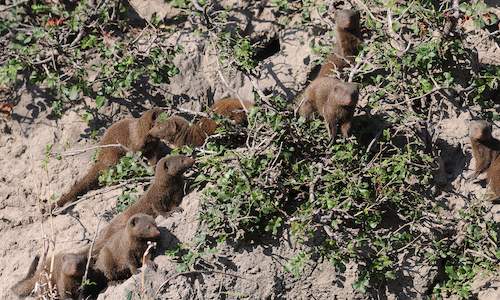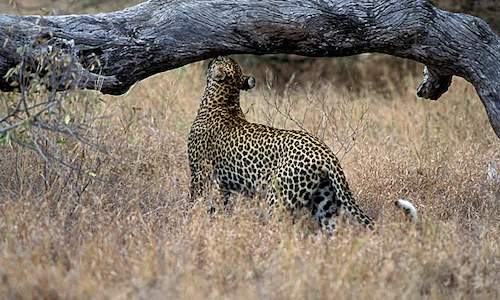
Pafuri is the most important locality for birds in Kruger, especially for rare vagrants and birds from tropical Africa. In total, 29 species or six per cent of the birds recorded in the Park have only been sighted at Pafuri. Some of these avian rarities include Trumpeter Hornbill, Cape Parrot, Tropical Boubou, Mashona Hyliota, broadbilled roller, olive bush shrike, threebanded courser, cinnamon dove, mottled spinetail and yellow white-eye.
Land Claims and Peace Parks
In December 1998, a Land Claims Court returned the triangle of land between the Luvuvhu and Limpopo rivers, in the far northern corner of the Park, to the Makuleke people. The Makuleke had been removed from the area in 1969 and settled elsewhere, and the land was incorporated into Kruger.In terms of a new agreement the area will now be jointly managed by the Kruger Park and the Makuleke for 25 years, and the community has been granted full rights to all tourism development, but will not settle on the land. This agreement made it possible to incorporate an additional 5 000 hectares of land into Kruger, and helped focus attention on the need to involve local rural communities in wildlife conservation.
A major initiative, led by the Peace Parks Foundation, is the proposed immense Kruger/Banhine-Zinave/ Gonarezhou Transfrontier Conservation Area (TFCA), encompassing a vast 95 712 square kilometres, which is larger than Austria or the USA's State of Indiana. The most ambitious of the Foundation's proposed transfrontier parks, it combines four existing national parks, controlled hunting areas and communal lands in South Africa, Mozambique and Zimbabwe. Much of the land is in Mozambique, where rural districts would benefit immensely from ecotourism and job creation.The Kruger Park receives nearly one million visitors a year, and cannot expand tourist facilities without negatively impacting on the environment. A major new airport has been completed west of Kruger (near Hoedspruit), but all of the Park's daily spare accommodation would be absorbed by the arrival of a single large passenger jet. Additional camps are needed to accommodate foreign tourists, and the proposed conservation area could sustain over one million wild animals, and would be able to accommodate three million tourists annually without any danger of overcrowding.Experts agree that conservation is the best form of land use for this Kruger National Park area, and the transfrontier park would make a significant contribution to the local economies of this semi-arid and undeveloped regions. As people are settled in some regions, the proposed transfrontier park would consist of a mosaic of protected areas and resource utilisation zones.In many parts of Africa poverty poses a major threat to national parks and natural resources, and land-hungry people have often violated park boundaries. The Peace Parks Foundation is confident that a three-pronged approach that addresses the problems of unemployment and poverty, establishes a culture of peace through co-operation between the member countries, and furthers the cause of conservation, will alter this pattern.On 24 October 1999, the responsible ministers from South Africa, Mozambique and Zimbabwe signed a Memorandum of Understanding, supporting the establishment of a joint management structure that will create one of the largest conservation areas in the world. The agreement established a Ministerial Committee and an International TFCA Technical Committee to oversee the implementation of the agreement. The Technical Committee, comprising officials from the three countries, will prepare a conceptual plan, draft agreement and final management plan by the end of 2001.The realisation of the dream of this transfrontier park will face certain obstacles, but none greater than those that faced Stevenson-Hamilton in the 1920s. In 1952 Stevenson-Hamilton published a history of his life in the Park, titled South African Eden - The Kruger National Park. Despite the vagaries of Nature, onslaughts from crippling droughts, opposition from many quarters and short-sighted decisions by government departments, the Kruger Park has endured and prospered.In part, its success has been built on a tasteful blend of rural architecture, unpretentious facilities, simple outdoor living and sensitive planning set against the backdrop of the unpredictable, untamed and enthralling pageant of nature. The Park has indeed become a South African Eden. And if it can play a critical role in the creation of an immense conservation area spanning three nations, this 'Eden' will be one worthy of World Heritage status and a wildlife sanctuary unsurpassed anywhere else in the world.
 The far north of Kruger is unique. This is because it is in the tropics, and the geological base is sandstone rather than the granites and b...
The far north of Kruger is unique. This is because it is in the tropics, and the geological base is sandstone rather than the granites and b... Pafuri Gate is about six-and-a-half hours' drive from Johannesburg and is the most northerly entrance to Kruger. Pafuri Gate Routes...
Pafuri Gate is about six-and-a-half hours' drive from Johannesburg and is the most northerly entrance to Kruger. Pafuri Gate Routes...